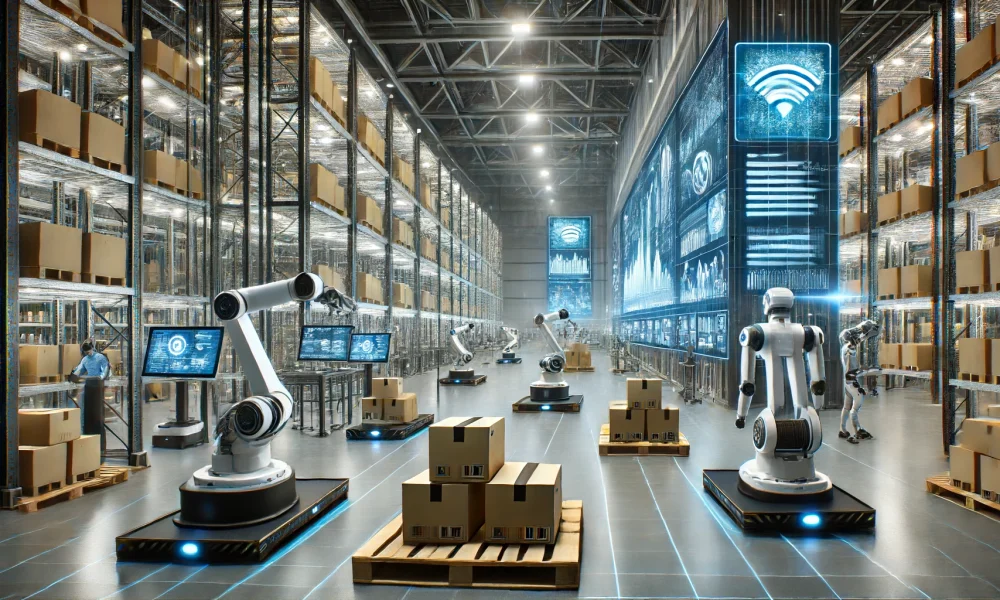Warehouse management is an intricate operation that requires balancing many challenges and risks. Customers increasingly expect fast, accurate deliveries, leading many companies to shift toward “micro fulfillment centers” located close to major urban centers. To fulfill orders quickly while making the most of limited warehouse space, organizations are increasingly turning to artificial intelligence (AI), machine learning (ML), and robotics to optimize warehouse operations. By utilizing AI and ML, warehouse managers can automate and improve components of their operations, such as forecasting demand and inventory levels, optimizing space utilization and layout, improving picking and packing efficiency, and reducing errors and waste. Meanwhile, robotics can perform repetitive tasks with greater accuracy and speed than human workers and operate in spaces too confined for humans. Organizations can harness these technologies to increase profits, enhance safety and security, and increase customer satisfaction and loyalty.
Challenges faced by the warehousing industry
Online commerce is rapidly expanding and evolving, becoming a $4,117.00 billion business in 2024. Customers are turning online for a variety of needs, including groceries. Traditionally, online retailers have stored their inventories in large warehouses outside major population centers. Rapid urbanization has led to many customers living in population hubs in expensive areas, and customers increasingly expect quick—often same-day—deliveries.
Many retailers have addressed this issue by implementing “micro fulfillment centers” near major population centers. Because real estate in these locations is expensive, it is more important than ever that every square foot of warehouse space is well-utilized. Meanwhile, the warehousing industry is dealing with labor shortages, making fulfilling orders in a timely fashion more difficult.
Applications of AI/ML and robotics
Automation, AI, and ML can help retailers deal with these challenges. The advancement of computer vision has expanded the possibilities for robotics in the warehouse space. For example, autonomous mobile robot (AMR) systems are increasingly used for picking (selecting the items that a specific customer has ordered), packing (preparing those items for shipping), and palletization (placing goods on a pallet for transportation and storage). Automating these tasks increases speed, efficiency, accuracy, and adaptability. Robotics can also utilize vertical and cramped spaces that are difficult for humans to access. Warehouse space can be further optimized by introducing innovative, high-density storage solutions like cubes, tubes, and automated storage and retrieval systems.
AI- and ML-powered optimization algorithms analyze massive amounts of real-world data to generate predictions and solutions, updating as more information becomes available. Route optimization helps companies ensure that goods are shipped along the shortest and most efficient routes. Demand forecasting and predictive modeling use past order data to identify patterns and help retailers estimate which products will likely be ordered by customers, ensuring that warehouse space is used efficiently and minimizing the time products spend on the shelves. These models also enable more efficient warehouse storage, as the more frequently ordered items can be stored closer to picking stations.
ML, when paired with sensors on equipment, can also enable predictive maintenance. Continuous monitoring of equipment parts allows warehouses to detect when mechanical parts like rollers or conveyor belts show signs of wear or breakage, allowing them to be replaced before failures happen and minimizing downtime. By implementing robotics and AI/ML-based solutions, retailers can increase accuracy and efficiency while ensuring their limited space is utilized to full capacity.
As AI and robotics are integrated into warehousing, it is vital to consider privacy, ethics, and workplace safety. It is crucial to consider data confidentiality and ensure that AI models do not leak sensitive customer data. Equally important is monitoring AI models for bias. Finally, it is essential to guarantee that robotic and automation solutions comply with Occupational Safety and Health Administration (OSHA) regulations to safeguard the workplace environment.
Key performance indicators for warehousing processes
Monitoring key performance indicators (KPIs) allows enterprises to measure the effectiveness of their warehousing solutions, enabling continuous improvement. A few key KPIs for warehousing include:
- Throughput – This represents the number of products successfully passed through a packing station during a set amount of time, for example, the number of orders fulfilled per hour.
- Lead time – This figure tracks how quickly shipments can be made.
- Cube utilization – This measure of how effectively warehouses use their storage capacity is often calculated by dividing the volume of materials stored by the total warehouse capacity.
- On-time in-full (OTIF) shipments – This metric calculates the percentage of orders completed in full by the desired date.
- Inventory count accuracy by location – This tracks the degree to which the goods stored in the warehouse correspond to the data. High inventory accuracy is necessary for warehouse analytics to be effective.
Reaping the benefits of AI/ML in warehousing
AI, ML, and robotics are significant components of modern warehousing and will continue to change the industry. According to a recent McKinsey report, companies plan to significantly increase their spending on autonomous warehouse solutions over the next five years. Major retailers like Target and Walmart are pouring millions of dollars into transforming their supply chains and storage operations with AI and ML-powered logistics. Walmart has developed an AI-powered route optimization tool, which has now been made available to other retailers under a software-as-a-service (SaaS) model. The retailer also uses AI to forecast demand and ensure adequate inventory on peak shopping days like Black Friday. These solutions help enhance customer satisfaction while increasing profits and lowering business operating costs. They can also help enterprises deal with challenges, including disruptions to the supply chain and labor shortages.
AI, ML, and robotics are most useful in smaller warehouses and micro-fulfillment centers, where they can optimize limited storage space. In addition to technologies like augmented reality and cloud solutions, they help make quick, accurate deliveries the standard. By monitoring key performance indicators and prioritizing compliance and data privacy, organizations can ensure that they reap the full benefits of AI, ML, and robotics.



